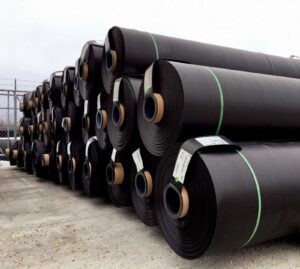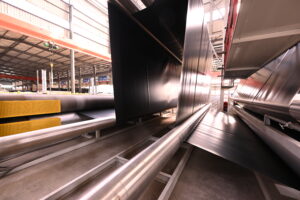Which material should be chosen for landfill geomembrane?
The selection of a landfill geomembrane often depends on several factors, including environmental conditions, geographic location, waste type and budget. Here are some common geomembrane material options, along with their benefits and use cases:
High Density Polyethylene (HDPE):
Benefits: HDPE geomembrane offers excellent chemical resistance and durability and is suitable for use as bottom and side covers in landfills. It is highly resistant to chemicals and penetrants.
Applicable situation: Suitable for most landfills, especially sites that require a high degree of anti-seepage.
Linear low density polyethylene (LLDPE):
Pros: LLDPE geomembranes excel in ductility and durability. It can adapt to surface unevenness and is relatively flexible.
Applicable situations: Suitable for anti-seepage covering layer on landfill surface, especially when better adaptability and ductility are required.
Polyvinyl chloride (PVC):
Advantages: PVC geomembrane has good durability and UV resistance. It can work in various temperature ranges and has good corrosion resistance.
Applicable situations: Suitable for general landfills, especially in high temperature environments.
Composite geomembrane:
Advantages: Composite geomembranes are usually composed of layers of different materials to take into account a variety of performance requirements. These can include HDPE, PP (polypropylene), etc. They can provide a variety of benefits, such as resistance to corrosion, durability, and resistance to penetration.
Suitable for: Suitable for landfills requiring a specific combination of properties.
Reinforced geomembrane:
Advantages: Reinforced geomembranes have reinforcing layers, such as fibers or mesh, for increased tear resistance and durability. These membranes are typically used where higher strength is required.
Suitable for: Suitable for landfills requiring enhanced performance, especially those sensitive to tearing and mechanical damage.
Geographic conditions, water tables, waste types, landfill design requirements, and applicable regulations and standards should also be considered when selecting a geomembrane.

How to install landfill geomembrane?
The installation of landfill geomembranes is a complex process that needs to be performed in accordance with professional engineering standards and best practices. The following are general geomembrane installation steps:
Preparation:
Clean and level the surface of the landfill, making sure there are no sharp objects or spikes that could puncture the geomembrane.
Remove clutter, vegetation and large objects from surfaces.
Base layer preparation:
A flat layer of base material, usually fine sand or gravel, is laid at the bottom of the landfill. This helps provide uniform support and reduce irregularities in the base of the geomembrane.
Geomembrane laying:
When laying the geomembrane, ensure that there is sufficient overlap at the ends of the membrane, usually 1-2 meters, to ensure effective anti-seepage.
Geomembranes should be spread flat over the base layer to prevent wrinkles and air pockets from forming, which could cause damage to the membrane or permeability issues.
When laying, be careful to avoid any activity that could puncture or damage the geomembrane and use non-metallic tools.
Seam treatment:
For the joints of the geomembrane, use hot melt or chemical welding methods to ensure the sealing of the joints.
Seam treatment should be completed by experienced professionals to ensure the firmness and impermeability of the seams.
Edge fixation:
The edges of the geomembrane should be secured to the perimeter of the landfill to prevent the membrane from shifting due to wind or other environmental factors. Often weights or other edge fixing methods are used.
Laying the covering layer:
The geomembrane is covered with a layer of slope protection soil, usually a material with good drainage and anti-penetration properties. This helps protect the geomembrane and mitigate the impact of the external environment.
Quality Control and Inspection:
Conduct quality control inspections to ensure geomembrane installation meets design specifications and requirements.
Regularly check the condition of the geomembrane and deal with any damage or problems promptly to ensure the impermeability of the landfill.
Please note that specific geomembrane installation steps may vary based on region, design requirements, and geomembrane material used.

What geotechnical materials should be used with landfill geomembrane?
The geomembrane of the landfill needs to be matched with some other geotechnical materials to ensure the stability, impermeability and environmental protection of the landfill. These geotechnical materials include:
Base material: Under the geomembrane, a layer of solid base material needs to be laid, usually using fine sand, gravel or other suitable materials. This layer of base material helps provide even support and reduce irregularities at the base of the geomembrane.
Fill material: On top of the waste layer in a landfill, a layer of fill material is required, usually soil or other fill material. This layer of fill helps reduce leakage and drainage and provides coverage and protection for the waste.
Slope protection soil: Slope protection soil is a layer of soil or other materials laid on the geomembrane to protect the geomembrane from ultraviolet radiation and mechanical damage. Slope protection soil should be a material with good drainage.
Drainage systems: To effectively drain water and prevent standing water, landfills often need to include drainage systems such as drainage pipes, stormwater drainage systems, and leachate collection systems.
Underground Aquiclude: Some landfills may require an underground aquifer to prevent infiltration into groundwater. This may include thicker or stronger geomembranes or other barrier materials.
Underground sewage collection system: In order to collect and treat leachate, landfills require underground sewage collection systems, including leachate pipes and collection tanks.
Impermeable layer repair materials: When damage or holes are found on the geomembrane, specialized repair materials are needed to repair these issues to maintain impermeability.
Edge fixing materials: Edge fixing materials are used to fix the edges of the geomembrane to prevent the membrane from moving due to wind or other environmental factors. Often weights, asphalt, or other edge fixing methods are used.
Author

Founded in 2002, Tinhy's team focuses on the manufacturing, marketing, installation, application and research and development of geosynthetic materials.
View all posts







